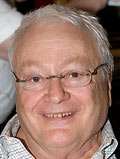
Some of the architecture world’s leading lights shared their knowledge and experiences in the Spring 2011 Department of Architecture Lecture Series.
The six public lectures, which began Feb. 16 and concluded April 11, took place in Preston Geren Auditorium, located in the Langford B building on the Texas A&M campus.
The Spring 2011 lecture lineup featured:
Lecture details and speaker bios:
 Feb. 16 — Jean Louis Cohen, the Sheldon H. Solow Professor in the History of Architecture at the Institute of Fine Arts at New York University, presented “Architecture Drafted: Designing for World War II,” a lecture covering the entire spectrum of the profession’s participation in the war.
Feb. 16 — Jean Louis Cohen, the Sheldon H. Solow Professor in the History of Architecture at the Institute of Fine Arts at New York University, presented “Architecture Drafted: Designing for World War II,” a lecture covering the entire spectrum of the profession’s participation in the war.
Cohen is author of “Casablanca, Colonial Myths and Architectural Ventures,” written with Monique Eleb; “Scenes of the World to Come: European Architecture and the American Challenge 1893-1960,” and “Le Corbusier and the Mystique of the USSR: Theories and Projects for Moscow, 1928-1936.”
The architecture historian, who works on a wide range of modernist subjects across diverse geographical regions including North Africa, Europe, and the Americas, has been honored with the title Chevalier des Arts & Lettres by the French Cultural Ministry, is a member of the Accademia di San Luca in Rome and the Russian Academy of Architecture.
 Feb 28 — Ila Bêka and Louise Lemoine, cofounders of the independent production company BêkaFilms, screened and discussed “Koolhaas HouseLife,” a film about a home designed by Dutch architect Rem Koolhaas.
Feb 28 — Ila Bêka and Louise Lemoine, cofounders of the independent production company BêkaFilms, screened and discussed “Koolhaas HouseLife,” a film about a home designed by Dutch architect Rem Koolhaas.
The thoroughly delightful film, wrote Ada Louise Huxtable in the Sept. 30, 2009 Wall Street Journal, offers an affectionate but unflinching look at the everyday life of a contemporary architectural masterpiece —or what happens to a celebrated building after the photographers are gone.
“Designed with the express purpose of restoring a meaningful existence to its handicapped owner, this is arguably the most spectacular exercise in reconfiguring domesticity in recent times; it would be hard to find anything to equal its radical departures from convention,” said Huxtable.
The film has been featured in festivals worldwide, including the Storefront for Art and Architecture in New York, a film series sponsored by the Architecture Foundation in London and the Venice Bienniale.
It’s one of a series of films they produced in the series “Living Architectures,” which depict the everyday lives of iconic architectural projects.
A trailer of “Koolhaas HouseLife” is available on Youtube.
 March 21 — Nate Hume, visiting assistant professor at the school of architecture at Pratt University and blogger who created suckerPUNCH, perhaps the Internet’s most important architecture site.
March 21 — Nate Hume, visiting assistant professor at the school of architecture at Pratt University and blogger who created suckerPUNCH, perhaps the Internet’s most important architecture site.
After earning a Master in Architecture degree from Yale University in 2007, Hume created suckerPUNCH after seeing there was no online architecture site displaying the most current, cutting-edge projects from designers throughout the world.
The site has included work from Zaha Hadid and Greg Lynn, as well as Texas A&M students, and hosts design competitions.
Hume worked for a time with Gage-Clemenceau Architects in New York after earning his master’s degree, then opened Hume-Coover Studio in Brooklyn, NY with Abby Coover.
 March 28 — Jose Oubrerie is the last living protégé of Le Corbusier, the French architect considered one of the pioneers of Modern architecture.
March 28 — Jose Oubrerie is the last living protégé of Le Corbusier, the French architect considered one of the pioneers of Modern architecture.
Oubrerie worked in Le Corbusier’s office from 1957 – 1965, collaborating with the master architect in the last years of his life. He was the chief designer of Saint-Pierre in Firminy, France.
“He worked on many of the later works of the office, most notably the design for Firminy church,” said George Ranalli, dean of the Spitzer School of Architecture at the City College of New York. “After Corbusier’s death, he went into practice and produced many excellent projects, especially the Miller House in Kentucky and the completion of the Firminy church. His work is extraordinary.”
 April 4 — Benjamin Ball said he wants to create experiences through design projects. “A building that is not built is not architecture,” he said.
April 4 — Benjamin Ball said he wants to create experiences through design projects. “A building that is not built is not architecture,” he said.
In his work with Gaston Nogues, Ball is exploring the intersection of architecture, art and product design through physical modeling and the use of digital and more traditional forms of production.
The Ball-Nogues studio recently completed “Cradle” – a giant Newton's Cradle made of stainless steel spheres hanging from cables on the wall of a Santa Monica parking structure designed by Frank Gehry. “Cradle” is an example of the firm's ability to create work that straddles the line between art and architecture, between permanence and ephemerality.
Ball-Nogues's other works include Gravity's Loom, part of the studio’s Suspensions series, on exhibit at the Indianapolis Museum of Art until March 2012. The piece consists of hundreds of multi-colored strings hanging together to create a 3-D space. By pairing simple materials such as string, cardboard and Mylar with cutting-edge technologies, the firm has created a portfolio of work.
After graduating from the Southern California Institute of Architecture, Ball sought work as a set and production designer for the “Matrix” series and other films, as well as music videos and commercials with influential directors such as Mark Romanek and Tony Scott.
Ball’s experience ranges from work on the Disney Concert Hall and small residential commissions for boutique firms to complex medical structures and event design.
 April 11 — Felicity Scott, assistant professor at Columbia University’s Graduate School of Architecture, Planning and Preservation concluded the lecture series with “Interact,” a lecture about her research on the Architecture Machine Group at the Massachusetts Institute of Technology. Founded by Nicholas Negroponte in 1967, thelaboratory and think tank studied new approaches to human-computer interaction.
April 11 — Felicity Scott, assistant professor at Columbia University’s Graduate School of Architecture, Planning and Preservation concluded the lecture series with “Interact,” a lecture about her research on the Architecture Machine Group at the Massachusetts Institute of Technology. Founded by Nicholas Negroponte in 1967, thelaboratory and think tank studied new approaches to human-computer interaction.
Specializing in architectural history and theory, Scott is the author of “Architecture or Techno-Utopia, Politics After Modernism” and “Antfarm.”
In her numerous, published articles on the history of twentieth-century America's architecture, she has critically situated architecture and its institutions into dialogue with the "underground"—featuring the experiments, practices, and polemics of the 1960s and 1970s.
 April 25 — Tom Wiscombe is principal of the Los Angeles firm EMERGENT, a Los Angeles-based firm internationally known for operating at the forefront of digital design. EMERGENT’s work is driven by models of biology and computation, as well as by contemporary design sensibilities. The May 2009 issue of ICON Magazine called Wiscombe “one of the top 20 architects in the world who are making the future and transforming the way we work."
April 25 — Tom Wiscombe is principal of the Los Angeles firm EMERGENT, a Los Angeles-based firm internationally known for operating at the forefront of digital design. EMERGENT’s work is driven by models of biology and computation, as well as by contemporary design sensibilities. The May 2009 issue of ICON Magazine called Wiscombe “one of the top 20 architects in the world who are making the future and transforming the way we work."
Wiscombe also worked with students to design create a futuristic housing prototype with special attention to technology’s role in the design at the college’s inaugural Mitchell Lab Visiting Designer Program.
- Posted: April 29, 2011 -
Contact: Phillip Rollfing, prollfing@archone.tamu.edu or 979.458.0442.
